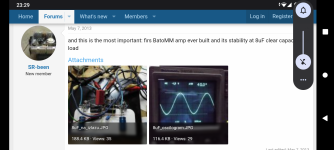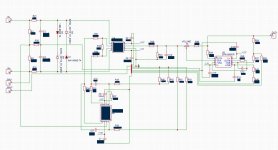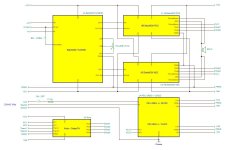Those 10uH looks very similar to those one in B100 ? But what I can see this one is open loop and have 0.0006% THD and B100 have 3 compensations? And even much better THD.
https://www.diyaudio.com/community/attachments/112517_10lo-jpg.582309/
https://www.diyaudio.com/community/attachments/112517_10lo-jpg.582309/
Nonsense.B100 looks like an variant of ULD MK3 class B ultra low noise amp, released in SiliconChip magasine 2011?
You must try BatoMM https://www.diyaudio.com/community/threads/bridged-lm3886-lme49720-remote-fb.255612/ before B100! : )
Last edited:
You really need to look at this with a 3-4V pk~pk square wave at 2-3 kHz with ~1us rise/fall times. Driving 8uF at LF with a sine wave is doable, but will be problematic at HF. That is one of the reasons for testing with a square wave - you can see how the amp deals with a very low impedance load (the capacitor) at HF. One of the issues is you get is HF OPS pole migration downwards in frequency and if the gain ends up being >0dB before the unity loop gain frequency the result is instability. You should use fast rise/fall times because it will also give you some idea as to how aggressive the amplifier front and bandwidth limiting filter is, or even if the amp has one (it should both for RF ingress filtering and to ensure the front end diff amp remains in the linear part of its operating region - whether it's a VFA or CFA). A small value output inductor of 0.5-2uH is extremely effective in isolating the amplifier output from capacitive loads.
There is a lot of information about BatoMM on the internet, so try to find it! it is an ultra low distortion amplifier, with remote sensing directly from the speaker terminals, it was a very popular amplifier in the countries of the former Yugoslavia and over 1000+ builds. The designer is Dragoljub Aleksijević - Macola. The most recent pcb is V1.5 from post 304 page 3, its designed carefuly by instructions from the peoples from yu3ma forum where the amplifier was created, I helped them and drew the PCB V1.5 voluntarily following their instructions, no one has tried the amplifier v1.5 yet, but if you want a proven good version, you can find it here ->https://github.com/yu3ma/BatoMM V1.5 is very similar to it, a bit more modern than that one from git. Peoples started simulating BTL version, it will be probably born very soon too. Frontend is brutaly good too, similar to this one but do not have i/v and tone control. https://www.diyaudio.com/community/threads/topping-b100.417717/post-7860188 That's all I can reveal to you. It's not interesting to me, I prefer class D, but I can recommend that you try making such amplifier, you will definitely not be disappointed, similar to b100 "laboratory like amp". : )
V2.0 is in plan, contain frontend from picture, and when done I will post in thread from post 304.
V2.0 is in plan, contain frontend from picture, and when done I will post in thread from post 304.
Attachments
Last edited:
Link to this global 'rule book'? Topping made an engineering decision. In the bench test context it obviously works brilliantly. The inarguable oversight was not making explicate in the manual that their balanced input can't be driven single ended. Small sacrifice for a niche application.this basic #1 rule of balanced interface technology
Topping definitely has room for growth. Elsewhere here I describe how my DX3 Pro Plus DAC apparently spews RF junk. With one amp the front panel display status was clearly audible at the speakers. Recently it also became apparent its headphone output isn't RF protected. Driving the Hidsz MP145's 4-wire cable - and only with the Hidsz - the DAC goes randomly 'unstable', humming loudly at non-AC related frequencies. Placing a hand on the chassis temporarily ameliorates it, as does balling up the headphone cable. These concerns are the main reasons for my holding off on a B100 purchase pending more market reports.
Sorry, this is absolutely self-evident.Link to this global 'rule book'?
Why on earth would one want to propagate the common-mode signal/noise through the the whole amplifier, even amplifying it? CMRR will degrade from any component/gain mismatches between paths, but the bigger problem is that you want to drive your bridged output stage symmetrically, with the common-mode signal removed to avoid early clipping and other ill-effects.
The whole idea of balanced interconnect technology is that the receiver must not make any assumptions about the signal on the input pins other than that the difference signal is the payload. To extract the payload and remove any common-mode stuff (be it signal or noise) you must perform a subtraction as soon as possible right at the input, period. The subtraction circuitry can either yield an unbalanced or balanced output signal. You will not be able to find any well-designed balanced input that works diffently.
That response adds little other than emphasis: self evident, must, whole point, what everybody does. "It's a rule because it really, really is a rule. We all agree."
Common node signals are unlikely to impact the speaker. The amp appears dual differential to the binding posts, both are driven. The voice is in effect a floating primary winding. From a topological viewpoint worst case scenario is common mode signals cancel at the voice coil. That's only a guess. If the circuit is fully differential throughout they may cancel at the input. Barring a schematic or XLR to binding post testing, common mode pass through remains an open question.
In the real world common mode signals are tiny. The engineering rationale for protecting against CM signals large enough to clip an amp is a tough one to build. Two ohm drive and marketing fluff side, Topping managed to engineer what may be from a test bench perspective the best measuring 50 watt amp available today while presumably ignoring all your essential rules. That should at least give pause for thought. You're engaging in idealism, not engineering.
Common node signals are unlikely to impact the speaker. The amp appears dual differential to the binding posts, both are driven. The voice is in effect a floating primary winding. From a topological viewpoint worst case scenario is common mode signals cancel at the voice coil. That's only a guess. If the circuit is fully differential throughout they may cancel at the input. Barring a schematic or XLR to binding post testing, common mode pass through remains an open question.
In the real world common mode signals are tiny. The engineering rationale for protecting against CM signals large enough to clip an amp is a tough one to build. Two ohm drive and marketing fluff side, Topping managed to engineer what may be from a test bench perspective the best measuring 50 watt amp available today while presumably ignoring all your essential rules. That should at least give pause for thought. You're engaging in idealism, not engineering.
With unbalanced source the common-mode signal is 1/2 payload signal and that is exactly the issue with the B100.In the real world common mode signals are tiny
Defining driving a balanced input with a single ended stimulus as common mode is novel. Presumably Topping provided unbalanced inputs to accommodate this eventually.
Brief update from non-experts / standard consumers.
I sent the amps off to my brother to see how they'd fare with a more 'typical' user. He knows pretty much less than nothing about what makes an amp an amp and any meaningful parameters. He wants to "hook it up and have it play music". I got them for curiosity. He agreed to try and use them.
All I told him is that they are "balanced monoblocks". I gave him some brief instruction re: connections / set up. He was (as previously mentioned) using these in place of a few other things I sent to use while his Forte 4A is with me for repair. Knowing the SE connections were suspect, I had him use balanced inputs from the Forte pre-amp.
20 mins after he called me to let me know he received the package, he called back.
"The #$@#% things don't work!".
tl;dr - with medium gain, small apartment, Vandersteen 2Ce, they immediately went into protection mode at "lower than normal" listening levels.
I didn't suspect this (or I'd have never sent them to him).
After a small amount of troubleshooting, we figured out that (for reasons I cannot explain whatsoever) the amps do not go into protection when his phonostage is the source (into the pre) when the amp is set to HI gain. The amps do not go into protection with a DAC as the source (into the pre) with the amp set to medium gain.
I haven't the foggiest of clues why switching to HIGHER gain keeps the amps from going into protection with the phonostage as a source. I've never measured his phono stage, but I'd imagine the output is relative to an older tape-deck vs. a modern DAC.
Anyway... this is just one completely anecdotal report of a 'normal' user experiencing nothing but frustration with these amps. I still find them curious, but... I still could not in good conscience recommend them to anyone that didn't know exactly what they were getting themselves into.
I sent the amps off to my brother to see how they'd fare with a more 'typical' user. He knows pretty much less than nothing about what makes an amp an amp and any meaningful parameters. He wants to "hook it up and have it play music". I got them for curiosity. He agreed to try and use them.
All I told him is that they are "balanced monoblocks". I gave him some brief instruction re: connections / set up. He was (as previously mentioned) using these in place of a few other things I sent to use while his Forte 4A is with me for repair. Knowing the SE connections were suspect, I had him use balanced inputs from the Forte pre-amp.
20 mins after he called me to let me know he received the package, he called back.
"The #$@#% things don't work!".
tl;dr - with medium gain, small apartment, Vandersteen 2Ce, they immediately went into protection mode at "lower than normal" listening levels.
I didn't suspect this (or I'd have never sent them to him).
After a small amount of troubleshooting, we figured out that (for reasons I cannot explain whatsoever) the amps do not go into protection when his phonostage is the source (into the pre) when the amp is set to HI gain. The amps do not go into protection with a DAC as the source (into the pre) with the amp set to medium gain.
I haven't the foggiest of clues why switching to HIGHER gain keeps the amps from going into protection with the phonostage as a source. I've never measured his phono stage, but I'd imagine the output is relative to an older tape-deck vs. a modern DAC.
Anyway... this is just one completely anecdotal report of a 'normal' user experiencing nothing but frustration with these amps. I still find them curious, but... I still could not in good conscience recommend them to anyone that didn't know exactly what they were getting themselves into.
???Defining driving a balanced input with a single ended stimulus as common mode is novel.
Quite a few interfaces with balanced outputs are impedance-balanced but not signal-balanced, notably with TRS output jacks. Also, any adapters or custom cables to go from unbalanced outs are also not signal-balanced, obviously. The impedance imbalance will reduce maximum CMRR with most reciever circuits but it still is 20...30dB, typically. But more importantly, sensing the voltage differential at the source (which is what balanced connections are all about) removes the symptom of those dreaded ground-loops because the offending noise current flows in a concductor which is not part of the signal transmission.
A balanced input which does not perform a subtraction to extract the correct payload signal without any common-mode signal is simply wrong. Relying on signal balance from the source to properly drive a bridge-tiel load is a significant engineering failure and totally unexcusable given that a proper receiver circuit does not add any cost.
Last edited:
Regardless of how much rebalancing done prior, the final separate active stages to bridge the outputs will create some imbalances due mismatches and common mode issues again at the load. The output impedance also doubled.
A SE gnd referenced output power amp is much better.
BTL types as in B100 gives higher power at lower voltages and single supply like in car audio.
A SE gnd referenced output power amp is much better.
BTL types as in B100 gives higher power at lower voltages and single supply like in car audio.
Last edited:
Many so called high end amps are balanced output.Regardless of how much rebalancing done prior, the final separate active stages to bridge the outputs will create some imbalances due mismatches and common mode issues again at the load. The output impedance also doubled.
A SE gnd referenced output power amp is much better.
BTL types as in B100 gives higher power at lower voltages and single supply like in car audio.
- Home
- Amplifiers
- Solid State
- Topping B100


